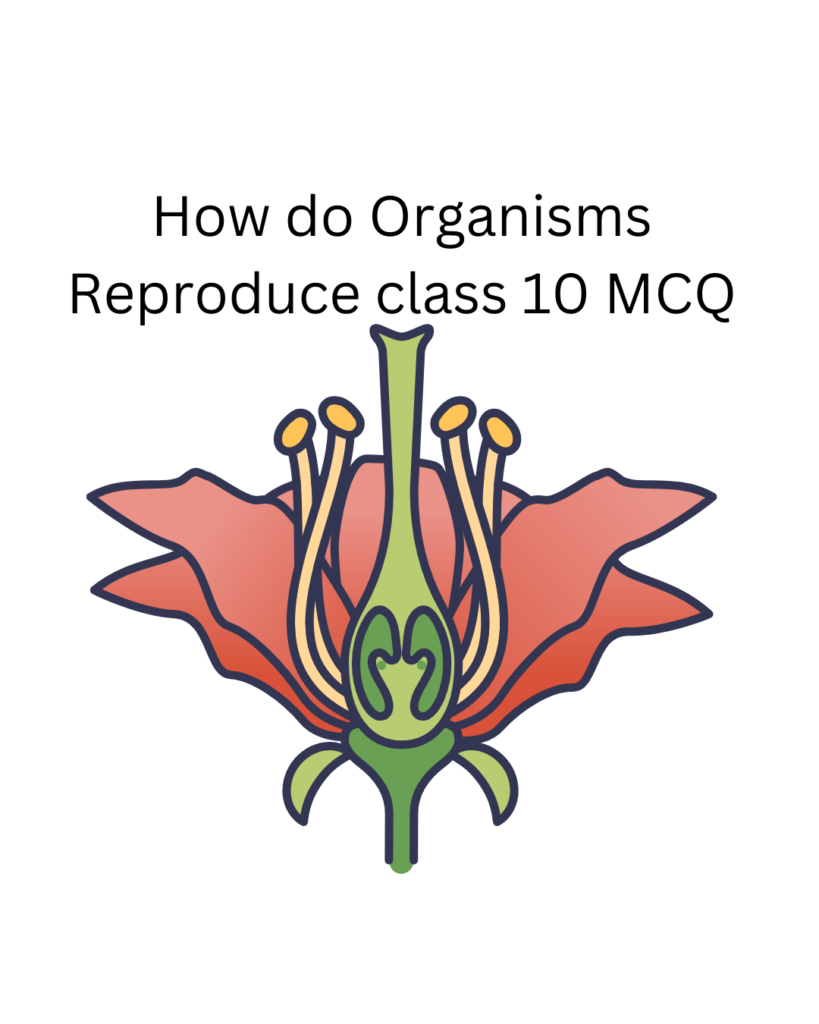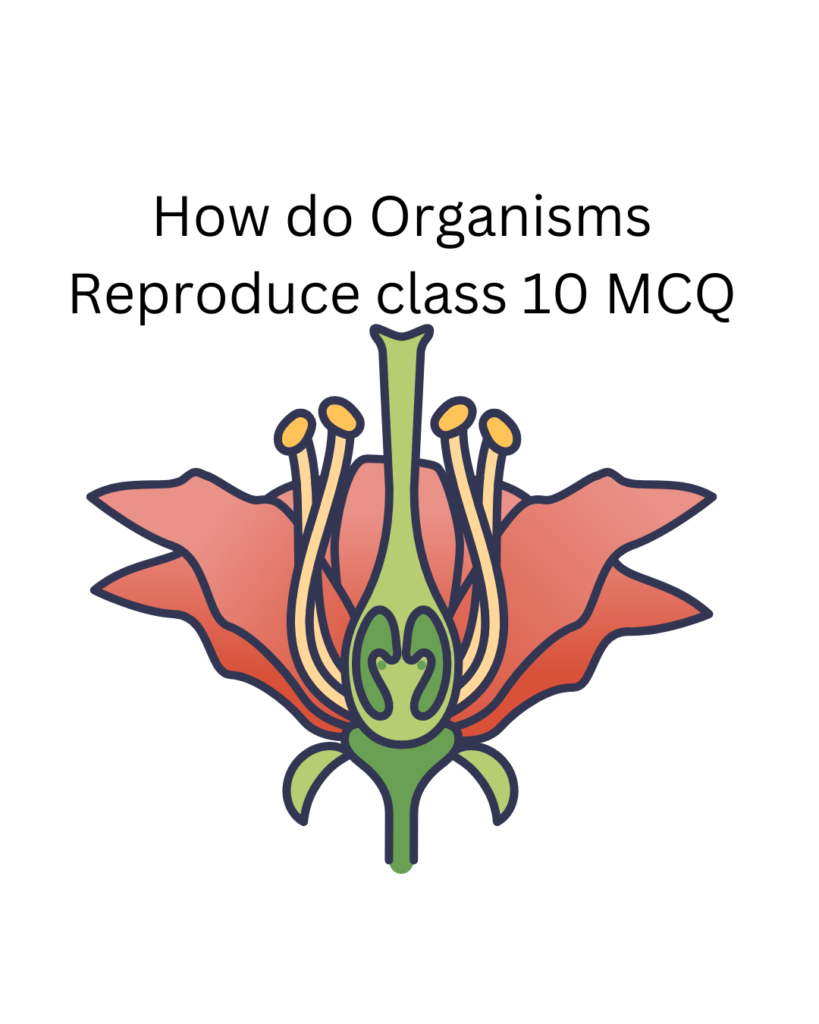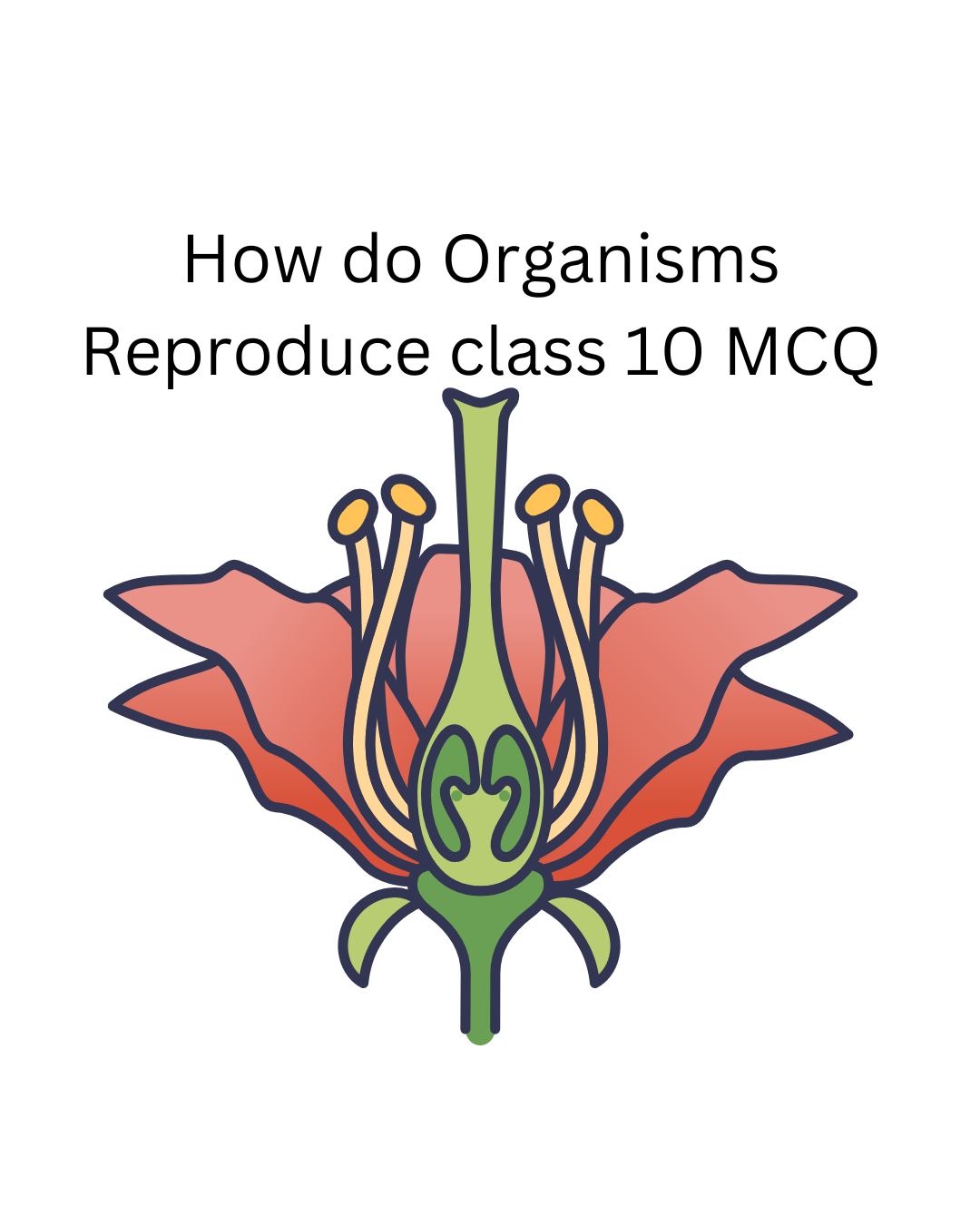How do Organisms Reproduce class 10 MCQ. Get the most important Class 10 Science Chapter 8 MCQs with answers. Covering key concepts from “How do Organisms Reproduce?”, these questions are perfect for CBSE Board Exam 2025 preparation.
How do Organisms Reproduce class MCQ

MCQs from “How do Organisms Reproduce?”
Section 1: Introduction to Reproduction
- Why do organisms reproduce?
a) To increase population
b) To maintain species continuity
c) To acquire energy
d) To adapt to the environment
Answer: b) To maintain species continuity - Which of the following is not a mode of reproduction?
a) Sexual
b) Asexual
c) Budding
d) Photosynthesis
Answer: d) Photosynthesis
Section 2: Asexual Reproduction
How do Organisms Reproduce class 10 MCQ
- Which method of reproduction is common in unicellular organisms?
a) Sexual reproduction
b) Binary fission
c) Pollination
d) Vegetative propagation
Answer: b) Binary fission - Budding is a method of reproduction seen in:
a) Amoeba
b) Hydra
c) Bacteria
d) Algae
Answer: b) Hydra - Which of the following organisms reproduce through spore formation?
a) Hydra
b) Yeast
c) Rhizopus
d) Planaria
Answer: c) Rhizopus - Vegetative propagation occurs in:
a) Potato
b) Dog
c) Frog
d) Amoeba
Answer: a) Potato
Section 3: Sexual Reproduction in Plants and Animals
How do Organisms Reproduce class 10 MCQ
- The reproductive part of a flower is:
a) Leaf
b) Stem
c) Root
d) Flower
Answer: d) Flower - Which part of the flower produces pollen grains?
a) Ovary
b) Petal
c) Anther
d) Stigma
Answer: c) Anther - Which of the following is a unisexual flower?
a) Rose
b) Mustard
c) Papaya
d) Hibiscus
Answer: c) Papaya - What is the function of the stigma in a flower?
a) Produces pollen grains
b) Protects the ovary
c) Receives pollen during pollination
d) Develops into fruit
Answer: c) Receives pollen during pollination
Section 4: Sexual Reproduction in Humans
- Which organ in the male reproductive system produces sperm?
a) Uterus
b) Testes
c) Prostate gland
d) Vas deferens
Answer: b) Testes - In females, fertilization occurs in the:
a) Ovary
b) Uterus
c) Fallopian tube
d) Vagina
Answer: c) Fallopian tube - Which hormone regulates the menstrual cycle in females?
a) Testosterone
b) Estrogen
c) Insulin
d) Thyroxine
Answer: b) Estrogen
Section 5: Reproductive Health and Contraception
- Which of the following is a surgical method of contraception?
a) Condoms
b) Oral pills
c) Copper-T
d) Vasectomy
Answer: d) Vasectomy - Which sexually transmitted disease is caused by a virus?
a) Syphilis
b) Gonorrhea
c) HIV/AIDS
d) Chlamydia
Answer: c) HIV/AIDS
Section 6: Asexual Reproduction – More MCQs
How do Organisms Reproduce class 10 MCQ
- Which of the following is not a type of asexual reproduction?
a) Binary fission
b) Budding
c) Pollination
d) Fragmentation
Answer: c) Pollination - Which of the following organisms reproduce by binary fission?
a) Planaria
b) Hydra
c) Amoeba
d) Fungi
Answer: c) Amoeba - Which part of the potato is used for vegetative propagation?
a) Root
b) Stem
c) Leaf
d) Bud (Eye)
Answer: d) Bud (Eye) - What type of reproduction is found in yeast?
a) Binary fission
b) Budding
c) Fragmentation
d) Spore formation
Answer: b) Budding - The filamentous structure that reproduces by fragmentation is:
a) Yeast
b) Paramecium
c) Spirogyra
d) Amoeba
Answer: c) Spirogyra
Section 7: Sexual Reproduction in Plants – More MCQs
How do Organisms Reproduce class 10 MCQ
- Which structure protects the developing seeds in a flower?
a) Ovary
b) Petal
c) Stigma
d) Anther
Answer: a) Ovary - What is the function of sepals in a flower?
a) To attract insects
b) To protect the bud
c) To produce pollen
d) To carry out photosynthesis
Answer: b) To protect the bud - The fusion of male and female gametes is called:
a) Pollination
b) Fertilization
c) Germination
d) Reproduction
Answer: b) Fertilization - Which of the following is an example of cross-pollination?
a) Pollen from the same flower fertilizing the ovule
b) Pollen from one flower fertilizing another flower of the same plant
c) Pollen from one plant fertilizing another plant of the same species
d) No transfer of pollen occurs
Answer: c) Pollen from one plant fertilizing another plant of the same species - Which plant structure develops into fruit after fertilization?
a) Ovary
b) Ovule
c) Anther
d) Stigma
Answer: a) Ovary
Section 8: Human Reproduction – More MCQs
How do Organisms Reproduce class 10 MCQ
- Which part of the female reproductive system is responsible for implantation?
a) Ovary
b) Uterus
c) Fallopian tube
d) Vagina
Answer: b) Uterus - Which of the following is the male reproductive hormone?
a) Estrogen
b) Progesterone
c) Testosterone
d) Oxytocin
Answer: c) Testosterone - In which organ are the female gametes produced?
a) Uterus
b) Ovary
c) Fallopian tube
d) Vagina
Answer: b) Ovary - How many chromosomes does a human sperm or egg cell contain?
a) 23
b) 46
c) 44
d) 92
Answer: a) 23 - Which of the following is the first step of human reproduction?
a) Embryo development
b) Gamete formation
c) Implantation
d) Childbirth
Answer: b) Gamete formation
Section 9: Reproductive Health and Contraception – More MCQs
How do Organisms Reproduce class 10 MCQ
- Which of the following is a barrier method of contraception?
a) IUD (Copper-T)
b) Condoms
c) Oral contraceptive pills
d) Tubectomy
Answer: b) Condoms - Which contraceptive method is 100% effective in preventing pregnancy?
a) Oral pills
b) Copper-T
c) Vasectomy/Tubectomy
d) Abstinence
Answer: d) Abstinence - Which of the following is not a sexually transmitted disease (STD)?
a) Syphilis
b) Tuberculosis
c) Gonorrhea
d) AIDS
Answer: b) Tuberculosis - What is the main function of the placenta?
a) To help in fertilization
b) To remove waste from the embryo’s blood
c) To produce eggs
d) To regulate the menstrual cycle
Answer: b) To remove waste from the embryo’s blood - Which of the following hormones is responsible for lactation (milk production) after childbirth?
a) Estrogen
b) Progesterone
c) Oxytocin
d) Testosterone
Answer: c) Oxytocin

Final Thoughts on How do Organisms Reproduce class 10 MCQ
✔ MCQs Cover Entire NCERT Chapter 8 – Perfect for CBSE Board Exam 2025
✔ Based on NCERT Important Lines – Helps in Quick Revision
✔ SEO-Optimized with Trending Keywords
How do Organisms Reproduce class 10 important MCQ
That’s all for the How do Organisms Reproduce class 10 MCQ, How do Organisms Reproduce MCQ Class 10, class 10 ch 8 science notes, class 10 biology ch 8 reproduction mcq, class 10 reproduction mcq test , mcqs from how do organisms reproduce?
Read related article https://stationvidya.com/mcqs-on-human-eye-and-the-colourful-world-class-10/
You can follow us on Instagram: https://www.instagram.com/stationvidya/
Facebook: https://www.facebook.com/stationvidya/
You tube: https://www.youtube.com/@stationvidya/
We hope you’d loved the content , please do like, share and comment.
Subscribe for notification

Leave a Reply